Please download PDF from above for all the following currencies.
Australian dollar // New Zealand dollar //Canadian dollar // Norwegian krone // Swedish Krona // Swiss franc // Czech koruna // Hungarian forint //Polish zloty // Romanian leu // Russian rouble // South African rand // Turkish lira // Indian rupee // Indonesian rupiah // Malaysian ringgit // Philippine peso //Singapore dollar // South Korean won // Taiwan dollar // Thai baht // Vietnamese dong // Argentine peso // Brazilian real // Chilean peso // Mexican peso // Crude oil // Saudi riyal // Egyptian pound
Monthly Foreign Exchange Outlook
DEREK HALPENNY
Head of Research, Global Markets EMEA and International Securities
Global Markets Research
Global Markets Division for EMEA
E: derek.halpenny@uk.mufg.jp
LEE HARDMAN
Senior Currency Analyst
Global Markets Research
Global Markets Division for EMEA
E: lee.hardman@uk.mufg.jp
LIN LI
Head of Global Markets Research Asia
Global Markets Research
Global Markets Division for Asia
E: lin_li@hk.mufg.jp
MICHAEL WAN
Senior Currency Analyst
Global Markets Research
Global Markets Division for Asia
E: michael_wan@sg.mufg.jp
EHSAN KHOMAN
Head of Commodities, ESG and Emerging Markets Research – EMEA
DIFC Branch – Dubai
E: ehsan.khoman@ae.mufg.jp
CARLOS PEDROSO
Chief Economist
Banco MUFG Brasil S.A.
E: cpedroso@br.mufg.jp
MAURICIO NAKAHODO
Senior Economist
Banco MUFG Brasil S.A.
E: mnakahodo@br.mufg.jp
MUFG Bank, Ltd.
A member of MUFG, a global financial group
December 2023
KEY EVENTS IN THE MONTH AHEAD
1) FINAL POLICY MEETINGS OF 2023
The US dollar fell sharply in November, by 3.0% - the largest drop since the same month in 2022 as the influence of central bankers’ mantra of “higher for longer” was questioned by market participants as inflation fell more sharply than expected, taking yields lower. In the context of that price action, we have a heavy schedule of central bank meetings in December that will be crucial for determining whether central banks push back on that mantra and acknowledge the faster declines in inflation. Eight of the G10 central banks will meet this month (RBNZ & Riksbank do not) with five of those meetings taking place in the week of 11th December. The FOMC on 13th December will of course be the primary focus for the markets given the yield drop in the US has been most pronounced following comments from Fed Governor Waller that suggested a possible shift in communication could be imminent. The scale of the US dollar sell-off has resulted in some of our Q1/Q2 2024 forecasts being achieved well ahead of time. We are reluctant to make wholesale changes to forecasts at this juncture and believe the global challenges that lie ahead will at least curtail further US dollar selling and could see some US dollar rebound over the near-term portion of our forecast profile.
2) BOJ FOCUS AHEAD OF POSSIBLE POLICY SHIFT
The final G10 central bank to meeting in 2023 will be the BoJ on 19th December. We expect no change at that meeting similar to the consensus but communication by Governor Ueda will be important given the expectations of a change in policy at the January meeting. In that context, the BoJ is holding a Workshop on 4th December to debate the benefits and costs of unconventional monetary policy which is part of the BoJ’s comprehensive review of its current monetary policy stance. The BoJ have already indicated this review will have no bearing on monetary policy decisions but Deputy Governor Uchida will deliver remarks at the event. While the event is closed to the public, a summary of the discussions will be published by the BoJ. No doubt any conclusions that suggest increased negative side-effects could reinforce expectations of a policy change early next year. The first meeting in 2024 takes place on 23rd January. MUFG expects YCC and NIRP to be terminated in January.
3) POSITIVE POLICY SUPPORTS ARE EXPECTED
On 24th November, the symposium of the National Committee of the Chinese People's Political Consultative Conference was held in Beijing. Focuses were on expressing opinions and suggestions on promoting the establishment of a new development model for the real estate industry, financial support for the steady and healthy development of the real estate market, and promoting the construction of affordable housing and etc. More stimulus policies likely will follow it and after the annual Central Economic Work Conference in December.
Forecast rates against the US dollar - End-Q1 to End-Q4 2024
|
Spot close 30.11.23 |
Q1 2024 |
Q2 2024 |
Q3 2024 |
Q4 2024 |
|
|
JPY |
147.87 |
138.00 |
136.00 |
134.00 |
132.00 |
|
EUR |
1.0905 |
1.0800 |
1.1000 |
1.1200 |
1.1400 |
|
GBP |
1.2634 |
1.2630 |
1.2790 |
1.2870 |
1.2950 |
|
CNY |
7.1350 |
7.0500 |
6.9500 |
6.8500 |
6.8000 |
|
AUD |
0.6613 |
0.6600 |
0.6700 |
0.6800 |
0.7000 |
|
NZD |
0.6163 |
0.6100 |
0.6200 |
0.6300 |
0.6450 |
|
CAD |
1.3587 |
1.3600 |
1.3400 |
1.3300 |
1.3200 |
|
NOK |
10.776 |
10.926 |
10.636 |
10.268 |
9.9120 |
|
SEK |
10.438 |
10.741 |
10.455 |
10.089 |
9.825 |
|
CHF |
0.8724 |
0.8700 |
0.8450 |
0.8480 |
0.8420 |
|
|
|
|
|
|
|
|
CZK |
22.271 |
22.920 |
22.730 |
22.540 |
22.370 |
|
HUF |
348.75 |
356.50 |
359.10 |
357.10 |
355.30 |
|
PLN |
3.9875 |
4.0740 |
4.0450 |
4.0180 |
3.9910 |
|
RON |
4.5549 |
4.6200 |
4.5640 |
4.5090 |
4.4560 |
|
RUB |
89.500 |
89.770 |
89.950 |
91.080 |
94.070 |
|
ZAR |
18.890 |
19.000 |
19.300 |
19.600 |
19.400 |
|
TRY |
28.851 |
31.500 |
33.000 |
34.500 |
36.000 |
|
|
|
|
|
|
|
|
INR |
83.390 |
83.500 |
83.000 |
82.500 |
82.000 |
|
IDR |
15505 |
15350 |
15200 |
15100 |
15000 |
|
MYR |
4.6590 |
4.6000 |
4.5500 |
4.5000 |
4.4500 |
|
PHP |
55.475 |
55.400 |
55.300 |
55.200 |
55.000 |
|
SGD |
1.3360 |
1.3250 |
1.3100 |
1.3000 |
1.2900 |
|
KRW |
1290.1 |
1285.0 |
1270.0 |
1250.0 |
1230.0 |
|
TWD |
31.260 |
31.200 |
30.900 |
30.650 |
30.400 |
|
THB |
35.182 |
34.400 |
34.200 |
33.900 |
33.600 |
|
VND |
24259 |
24200 |
24150 |
24100 |
24000 |
|
|
|
|
|
|
|
|
ARS |
360.56 |
800.00 |
950.00 |
1020.0 |
1100.0 |
|
BRL |
4.9295 |
5.1300 |
5.1600 |
5.1800 |
5.2000 |
|
CLP |
866.80 |
880.00 |
890.00 |
895.00 |
900.00 |
|
MXN |
17.383 |
17.300 |
17.500 |
17.700 |
17.700 |
|
|
|||||
|
Brent |
82.73 |
91.00 |
88.00 |
83.00 |
87.00 |
|
NYMEX |
75.25 |
86.00 |
83.00 |
79.00 |
83.00 |
|
SAR |
3.7511 |
3.7500 |
3.7500 |
3.7500 |
3.7500 |
|
EGP |
30.850 |
31.500 |
32.300 |
34.100 |
35.000 |
Notes: All FX rates are expressed as units of currency per US dollar bar EUR, GBP, AUD and NZD which are expressed as dollars per unit of currency. Data source spot close; Bloomberg closing rate as of 4:30pm London time, except VND which is local onshore closing rate.
US dollar
|
Spot close 30.11.23 |
Q1 2024 |
Q2 2024 |
Q3 2024 |
Q4 2024 |
|
|
USD/JPY |
147.87 |
138.00 |
136.00 |
134.00 |
132.00 |
|
EUR/USD |
1.0905 |
1.0800 |
1.1000 |
1.1200 |
1.1400 |
|
Range |
Range |
Range |
Range |
||
|
USD/JPY |
134.00-150.00 |
132.00-148.00 |
130.00-146.00 |
128.00-144.00 |
|
|
EUR/USD |
1.0600-1.1400 |
1.0700-1.1600 |
1.0800-1.1700 |
1.0900-1.1900 |
MARKET UPDATE
In November the US dollar weakened sharply against the euro in terms of London closing rates, from 1.0562 to 1.0905. In addition, the dollar weakened versus the yen, from 151.56 to 147.87. The FOMC at its meeting at the beginning of November held the fed funds rate at between 5.25% and 5.50%. The FOMC has continued with its policy of reducing its securities holdings with QT ongoing at a pace of USD 95bn worth of UST bonds (USD 60bn) and MBS (USD 35bn) of balance sheet reduction each month. The balance sheet has now shrunk to USD 7,796bn, down USD 8,965bn from the peak in April 2022.
OUTLOOK
The US dollar weakened sharply in November, by 3.0% - the biggest drop since the same month in 2022. There were a number of factors, which combined, prompted an increase in confidence that the Fed’s tightening cycle is over and that perhaps the Fed could commence monetary easing sooner than previously assumed. A weaker than expected jobs report, a CPI print that also contained elements that were weaker than expected and then rhetoric from a senior Fed official that prompted a drop in US yields all helped fuel dollar selling. Market participants are on high alert for signs of a shift from the Fed away from communications arguing “higher for longer” and the comments from Governor Waller on 28th November suggested a shift may have started. Waller was the first senior Fed official (and more of a hawk) to discuss possible scenarios for rate cuts in 2024 with inflation continuing to come down without necessarily much weaker growth. It is merely the first possible sign of a shift in tone and as a result the 2-year UST bond yield fell by 41bps in November, the largest single month drop since March.
These comments therefore could prove important if the scenario laid out by Waller starts to play out. We certainly see scope for disinflationary forces to continue although not at the pronounced rate over past months and hence that could fuel a further positioning for a sooner cut and for the cumulative total for 2024 to increase further. This would see the 2s10s bull-steepen which historically has been US dollar negative. There is certainly scope for the front-end to outperform as the economy slows while longer-term rate declines could be curtailed by supply concerns. The US fiscal deficit outlook remains a concern with IMF projections showing little improvement out to 2028 with deficit-to-GDP estimates between 6.0%-7.0%. Next year will also see the focus on US politics intensify with the presidential election in November. Donald Trump currently looks in a strong position to potentially beat Joe Biden which will only serve to intensify the poor US fiscal and debt outlook.
The scenario of lower inflation and weaker growth fuelling expectations of increased scope for monetary easing will weaken the dollar further. However, we have seen a sharp sell-off in November and a sharp drop in yields. Given the unfavourable global growth backdrop, we see near-term limits to further dollar selling for now.
INTEREST RATE OUTLOOK
|
Interest Rate Close |
Q1 2024 |
Q2 2024 |
Q3 2024 |
Q4 2024 |
|
|
Policy Rate |
5.33% |
4.88% |
4.38% |
3.88% |
3.38% |
|
3-Month Yield |
5.39% |
4.68% |
4.18% |
3.70% |
3.24% |
|
10-Year Yield |
4.33% |
4.38% |
3.88% |
3.63% |
3.50% |
* Interest rate assumptions incorporated into MUFG foreign exchange forecasts.
In the past month the US rates market has gone from fearing the ongoing deluge of larger bond supply to embracing the Fed is done view post the last FOMC meeting and weaker and lower than expected NFP, along with the latest inflation readings. Long-time readers will recall that our view, since mid-summer 2023, is that the last Fed hike in July was likely the last, that it also sets off the countdown to how long can they stay on hold at the current peak in Fed Funds of 5.25-5.50%. Markets have come around to our view by pricing in further cuts and pulling forward the start of cuts into the 1st half of 2024. Given that there is a convergence of forward rates to our historically lower, and up until recently, out-of-consensus rate path, we make no changes to our rates path from the prior month. That said, a combination of short positioning and thin into year-end markets, has led to rates moving faster than currently justified. The next major event is the last FOMC for the year where we expect the Fed to stay on hold but not meet the currently dovish priced rate level expectations. Any sort of push back should bring markets better balanced and into a range-trading grid up in rates. (George Goncalves, Head of US Macro Strategy)
US PROJECTED BUDGET DATA % OF GDP
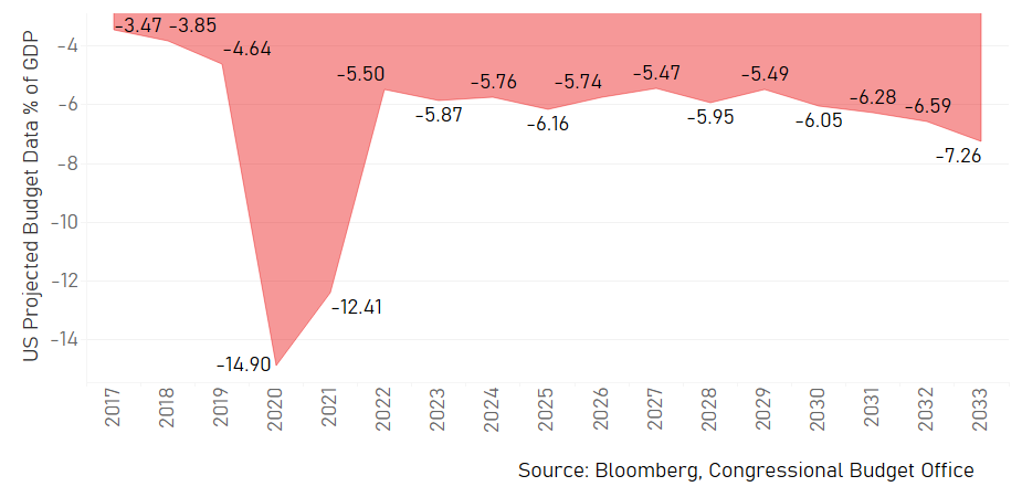
US TREASURY BOND YIELDS
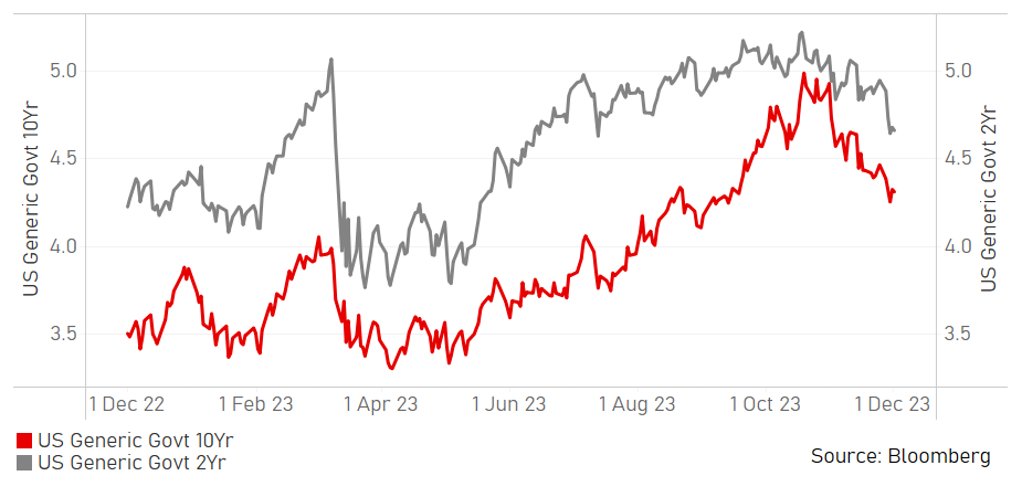
Japanese yen
|
Spot close 30.11.23 |
Q1 2024 |
Q2 2024 |
Q3 2024 |
Q4 2024 |
|
|
USD/JPY |
147.87 |
138.00 |
136.00 |
134.00 |
132.00 |
|
EUR/JPY |
161.25 |
149.00 |
149.60 |
150.10 |
150.50 |
|
Range |
Range |
Range |
Range |
||
|
USD/JPY |
134.00-150.00 |
132.00-148.00 |
130.00-146.00 |
128.00-144.00 |
|
|
EUR/JPY |
148.00-163.00 |
146.00-161.00 |
144.00-159.00 |
142.00-157.00 |
MARKET UPDATE
In November the yen strengthened versus the US dollar in terms of London closing rates from 151.56 to 147.87. However, the yen weakened versus the euro, from 160.08 to 161.25. The BoJ did not meet in November and hence its YCC framework, which was altered in October, was left unchanged with the +100bps range maintained but the upper-end of 1.00% described more as a reference rather than a hard limit. The BoJ has still committed to “large-scale” JGB buying when required which creates greater uncertainty over the reaction function of the BoJ to JGB yield moves going forward. The key policy rate also remained unchanged at -0.10%.
OUTLOOK
The yen strengthened in November versus the US dollar but underperformed nearly all of the rest of G10 with only CAD performing worse. The correction lower therefore was really focused on US dollar factors with the weaker inflation data and growing expectations of more Fed rate cuts in 2024 fuelling the USD/JPY move. Given the scale of the drop in short-term US rates, the drop in USD/JPY was perhaps more modest than expected. While the yield spread is now narrowing, it remains substantial and appears to be prompting USD/JPY buying on dips. IMM positioning data revealed a big jump in JPY short positions. Still, we view this a risky strategy and one that is unlikely to be sustained given the primary driver of USD/JPY to the highs around 150.00 was global inflation and higher rates, which are now reversing. Our own short-term regression model estimates current fair-value is at 143.00.
While US yield developments will be most important, the smaller declines in USD/JPY than other USD/G10 crosses could reflect the still aggressive policies in Japan to lift inflation permanently closer to the BoJ’s 2% goal. The latest example of this was the government’s stimulus package that will total JPY 17trn with JPY 13.1trn funded through an extra budget. The package is spun as action to shelter households from inflation. This is true in that it includes subsidies for gas, electricity and gasoline prices but also includes tax rebates and an income tax cut effective next year. The stimulus has the potential to lift demand and with it inflation, which will only serve to reinforce the BoJ deeply negative policy rate measured in real terms.
BoJ policy tightening expectations have yet to have any notable impact on JPY performance. Previous bouts of JPY strength on YCC tweaks have quickly reversed. However, the changes we expect in January will include the removal of NIRP, which is now partially priced but we suspect the communication from the BoJ will indicate a growing confidence in price stability being achieved and will leave open the prospect of further rate hikes beyond the 20bps we expect at the January meeting.
Given slowing growth in the US and falling inflation, global yields have further to fall. The BoJ’s shift in policy will add to prospects of a yen rebound with scope for a USD/JPY drop of more than 10% next year.
INTEREST RATE OUTLOOK
|
Interest Rate Close |
Q1 2024 |
Q2 2024 |
Q3 2024 |
Q4 2024 |
|
|
Policy Rate |
-0.10% |
0.10% |
0.10% |
0.10% |
0.30% |
|
3-Month Yield |
-0.16% |
0.10% |
0.10% |
0.10% |
0.30% |
|
10-Year Yield |
0.67% |
1.00% |
1.10% |
1.20% |
1.30% |
* Interest rate assumptions incorporated into MUFG foreign exchange forecasts.
The 10-year JGB yield fell sharply in November, by 27bps to close at 0.67%, the lowest level since the closing level in August. The global backdrop of falling inflation and long-term yields was the key determinant of the move in JGBs as well. But what we did hear from the BoJ in November still conveyed a degree of caution over concluding that the price stability goal has been achieved. Governor Ueda toward the end of November stated that there was not “enough certainty on attaining the inflation goal” which leaves the decision in January a close call. The expectations that NIRP will be scrapped is certainly weighing in demand for bonds at the front-end of the curve. A 2yr JGB auction at the end of November saw the bid-to-cover fall to 2.91, down from the previous auction and below the 12mth average. The 10-year JGB yield is now better priced for the end of YCC given the step-by-step changes that have already taken place allows the yield to trade in a wider range. Still, the uncertainty over possible policy changes to YCC and NIRP could see renewed volatility and upward pressure on yields re-emerging.
JAPAN VS. MAJORS (EX JAPAN) YIELD RETURN
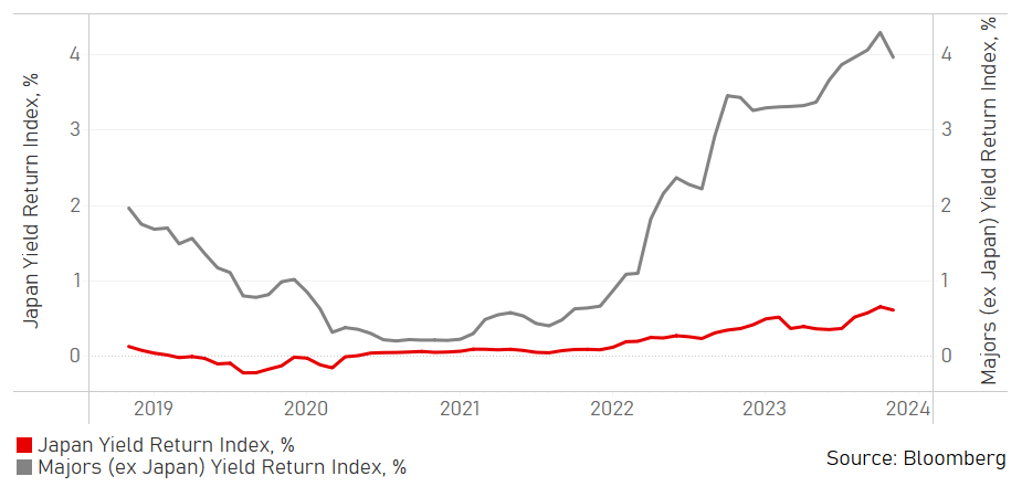
BOJ PURCHASES OF JGBS
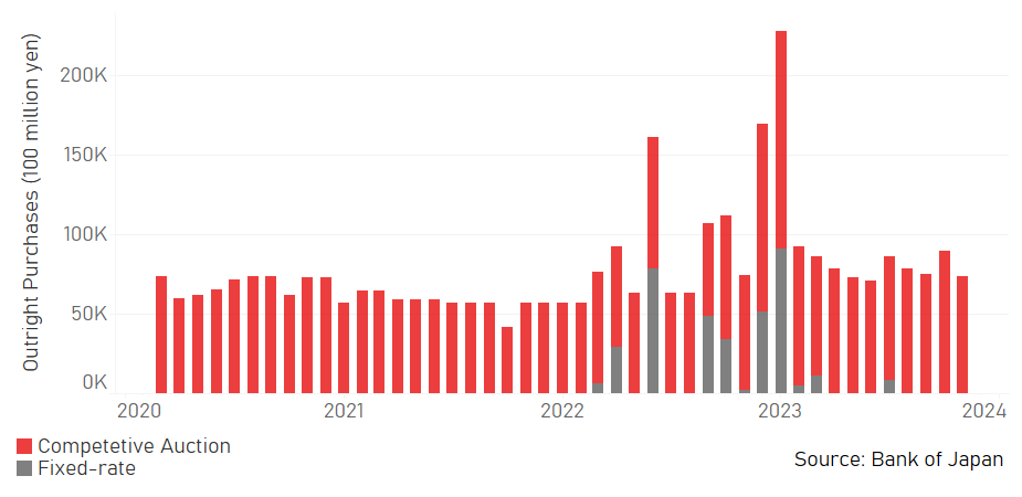
Euro
|
Spot close 30.11.23 |
Q1 2024 |
Q2 2024 |
Q3 2024 |
Q4 2024 |
|
|
EUR/USD |
1.0905 |
1.0800 |
1.1000 |
1.1200 |
1.1400 |
|
EUR/JPY |
161.25 |
149.00 |
149.60 |
150.10 |
150.50 |
|
Range |
Range |
Range |
Range |
||
|
EUR/USD |
1.0600-1.1400 |
1.0700-1.1600 |
1.0800-1.1700 |
1.0900-1.1900 |
|
|
EUR/JPY |
148.00-163.00 |
146.00-161.00 |
144.00-159.00 |
142.00-157.00 |
MARKET UPDATE
In November the euro strengthened sharply versus the US dollar in terms of London closing rates, moving from 1.0562 to 1.0905. The ECB did not meet in November and hence the key policy rate remained at 4.00% for the second consecutive meeting, following 450bps of rate hikes through to September. The ECB is running down APP securities at a pace of around EUR25 billion per month. An ECB review of its operational framework is expected to be completed around spring 2024.
OUTLOOK
EUR/USD looks like it will end 2023 higher than we anticipated and the window of US dollar strength to take EUR/USD back below the 1.0500-level has most likely closed with US yields sharply lower and inflation slowing. EUR/USD advanced 2.9% in November, the biggest gain in a year as rate cut expectations in the US fuelled US dollar selling. While US developments were key, the flow of data in the euro-zone was also notable and does suggest caution is warranted over the sustainability of this move higher in EUR/USD. Inflation data from Germany, Spain, France and for the euro-zone all came in much weaker than expected – incredibly the headline CPI rate for the euro-zone is now just 0.4ppt from the 2.0% target. Allowing for some modest pick-up int the annual CPI rate in December, the 2023 actual CPI level is looking like coming in less than the 5.6% ECB projection. Headline inflation is falling faster than the initial rise – it took 15mths from the headline rate at 2.2% to hit the peak of 10.7% and has taken 13mths to fall back to 2.4% as of November. Core inflation lags headline but core is now slowing sharply. The 6mth annualised change in core CPI fell to 0.8% in November, the weakest growth rate since February 2021 during covid.
So a clearer shift in rhetoric from the ECB could well come sooner than thought. Market pricing is showing the first rate cut of 25bps fully priced by the April meeting. We have brought forward our first rate cut into Q2 (from Q3) but assume June, but April is certainly plausible. So having thought the ECB would hike after the Fed, it is now reasonable to assume the ECB could cut first. It is not just the weaker than expected inflation. German GDP outlook has deteriorated following the German constitutional court’s decision to rule the off-balance sheet special funds allotted for covid cannot be used for climate-change related investments or be extended for other purposes into a new fiscal year. This means energy price subsidies will end sooner than planned leaving German consumers exposed to higher prices. Around a EUR 35bn shortfall needs to be covered next year and about EUR 25bn for the following year. Suspending the debt brake is a possibility but this will not alleviated the uncertainties that will likely curtail households and companies appetite to spend and invest. This is a bad development at the heart of the euro-zone.
We remain of the view that EUR/USD can advance in 2024 but the speed of the jump in November and the speed of decline in inflation in the euro-zone makes us cautious over the extent of gains from here, certainly in the first half of 2024
INTEREST RATE OUTLOOK
|
Interest Rate Close |
Q1 2024 |
Q2 2024 |
Q3 2024 |
Q4 2024 |
|
|
Policy Rate |
4.00% |
4.00% |
3.75% |
3.50% |
3.00% |
|
3-Month Yield |
3.78% |
3.80% |
3.50% |
3.20% |
2.70% |
|
10-Year Yield |
2.45% |
2.30% |
2.20% |
2.00% |
1.80% |
* Interest rate assumptions incorporated into MUFG foreign exchange forecasts.
The notable drop in yields in the US has of course reverberated everywhere and the 10-year German bund yield fell by 36bps in November, to close at 2.45%. It was the largest monthly drop in the 10-year yield since July 2022. As highlighted above, inflation is now clearly coming down faster than anticipated and this could see yields decline even further. However, the scale of the drop does suggest the downside from here is limited for now – yes, inflation has dropped markedly but the ECB will likely maintain its rhetoric for now and there is a chance over the coming months for base-effects to result in some modest increases in the annual CPI rates. But the scope for an ECB rate cut by Q2 certainly looks credible especially given the likely continued weak economic backdrop. The debt brake is likely to be suspended for a fourth year in a row in Germany but the government remains under severe pressure to tighten fiscal policy following the constitutional court’s decision on using covid-related funds for other means in other fiscal years. This is not the time for more severe austerity and could mean lower long-term yields than we currently assume.
EURO AREA HARMONISED INDEX OF CONSUMER PRICES
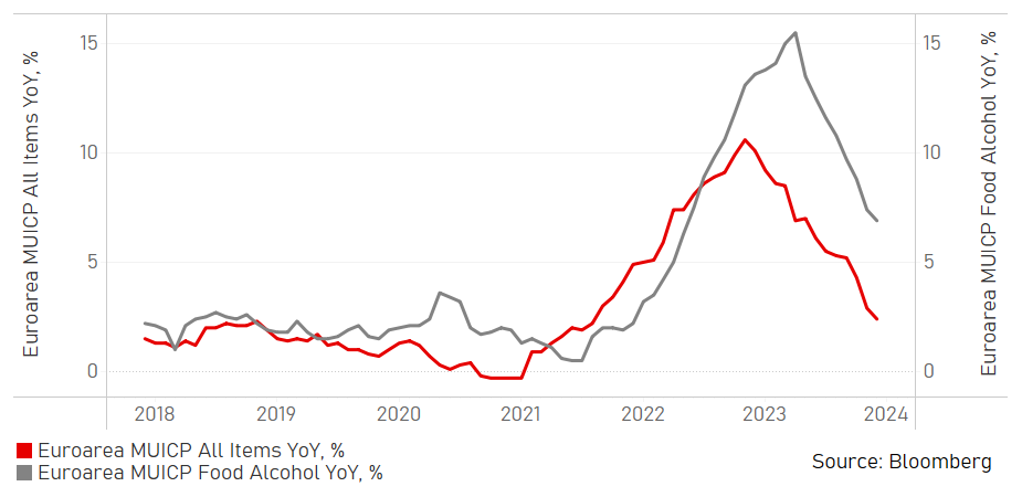
EUR/USD VS. EUR/USD IMPLIED VOLATILITY (1-WEEK)
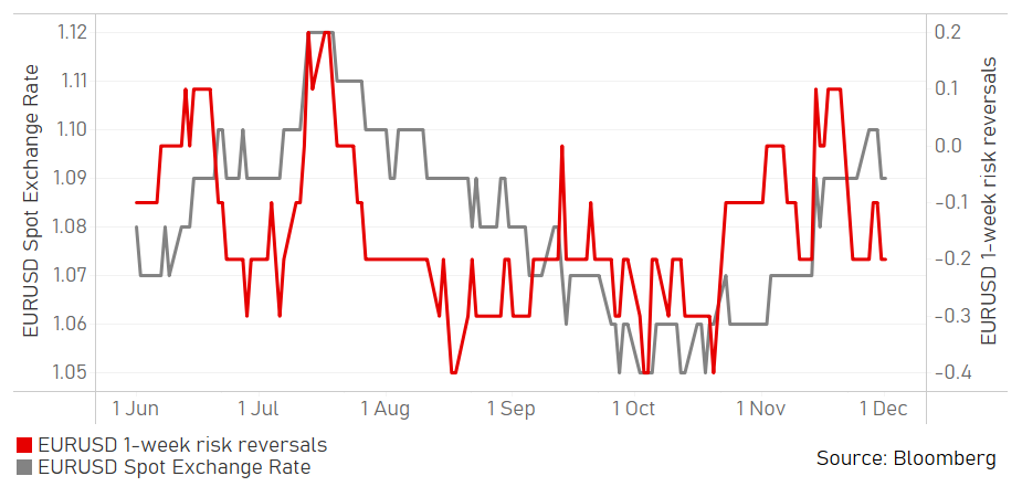
Pound Sterling
|
Spot close 30.11.23 |
Q1 2024 |
Q2 2024 |
Q3 2024 |
Q4 2024 |
|
|
EUR/GBP |
0.8631 |
0.8550 |
0.8600 |
0.8700 |
0.8800 |
|
GBP/USD |
1.2634 |
1.2630 |
1.2790 |
1.2870 |
1.2950 |
|
GBP/JPY |
186.82 |
174.30 |
174.00 |
172.50 |
171.00 |
|
Range |
Range |
Range |
Range |
||
|
GBP/USD |
1.2350-1.3300 |
1.2400-1.3400 |
1.2450-1.3500 |
1.2500-1.3600 |
MARKET UPDATE
In November the pound strengthened sharply against the US dollar in terms of London closing rates from 1.2127 to 1.2634. The pound strengthened more modestly against the euro, from 0.8709 to 0.8631. The MPC at its meeting in November held the key policy rate at 5.25% for the second consecutive meeting, following 14 consecutive rate increases through to August before a pause in September.
OUTLOOK
The pound gained in November like all currencies against the US dollar and managed a small gain against the euro. The euro underperformed in response to the shift in ECB rate cut expectations after the inflation data in November. It is certainly evident from the data in the UK that inflation is looking stickier despite the larger drop in the annual rate in October. YoY CPI fell from 6.7% to 4.6% in October, more than expected. However, the underlying inflation backdrop remains more problematic in the UK than in Europe or in the US. The core CPI YoY rate fell from 6.1% to 5.7% but the services CPI YoY rate remains a lot higher and while that measure fell too, it remains too high at 6.6%. That is often cited as the key measure by MPC members as it reflects the domestically-driven inflation pressures. With the jobs market still tight and wage growth much more elevated here than in the euro-zone or the US, the inflation risks remain higher. New experimental data from the ONS published in November revealed the unemployment rate had dropped to 3.5% suggesting a stronger than expected jobs market. Wage growth on a 3mth YoY basis slowed from 8.2% in August to 7.9% in September.
The incoming data, while is likely to move in a disinflationary direction, will force the BoE to be a lot more cautious on cutting rates. The OIS market currently implies a first 25bp rate cut taking place in August. This seems reasonable to us given the inflationary backdrop in the UK. To what extent this greater reluctance to cut from the BoE is GBP supportive will depend on the health of the economy. Our assumption is that incoming economic data will show further weakness which will limit any yield benefit for GBP. Tighter monetary policy still has not fully reverberated through the economy and growth is barely positive. Real GDP was flat in Q3 with private consumption contracting by 0.4%. The Autumn Statement included a National Insurance Contribution tax cut but the maintenance of the tax thresholds will result in the overall tax-take as a % GDP increasing further. The 100% expensing of capital investment is a positive longer-term but from a near-term growth perspective the removal of a deadline means there will be no surge in investment ahead of a deadline. The OECD’s GDP forecasts show the UK 2nd from bottom in 2024.
Previously we had forecast GBP underperformance with EUR/GBP trending softly higher. Given the shift in our view to a sooner ECB rate cut and given the need for the BoE to remain cautious, EUR/GBP could turn lower and stay in a narrower range than we assumed before. We expect GBP gains versus USD
INTEREST RATE OUTLOOK
|
Interest Rate Close |
Q1 2024 |
Q2 2024 |
Q3 2024 |
Q4 2024 |
|
|
Policy Rate |
5.25% |
5.25% |
5.25% |
5.00% |
4.50% |
|
3-Month Yield |
5.33% |
5.30% |
5.15% |
4.70% |
4.20% |
|
10-Year Yield |
4.18% |
4.10% |
4.00% |
3.80% |
3.60% |
* Interest rate assumptions incorporated into MUFG foreign exchange forecasts.
Like elsewhere, the 10-year Gilt yield fell sharply in November, by 33bps to close at 4.18%. The drop in yield was similar to the decline in core Europe but smaller than in the US. As stated above, there is a risk that inflation in the UK remains stickier than in the euro-zone or in the US and this divergence could also be reflected in smaller declines in UK yields in 2024. Inflation expectations remain elevated according to the BoE’s Decision Maker Panel survey which has 1yr inflation at 4.4% and 3yr inflation at 3.2%. This is not hugely different from surveys elsewhere but the wage expectation was at 5.1% over the next year and highlighted the labour market risks to price stability. Yields in the UK could also be supported by the fiscal outlook. The government’s limited room for manoeuvre was highlighted by the Autumn Statement. The scope for tax cuts were only allowed by the threshold remaining unchanged thus bringing in more taxes in total while there is a high risk of fiscal slippage given the projection of debt stabilising and coming down over the longer-term is only achieved by very large cuts in departmental spending in real terms. Gilt yields can come down but a little less than in the euro-zone and the US.
UK WAGE GROWTH VS. UK CPI YOY,%
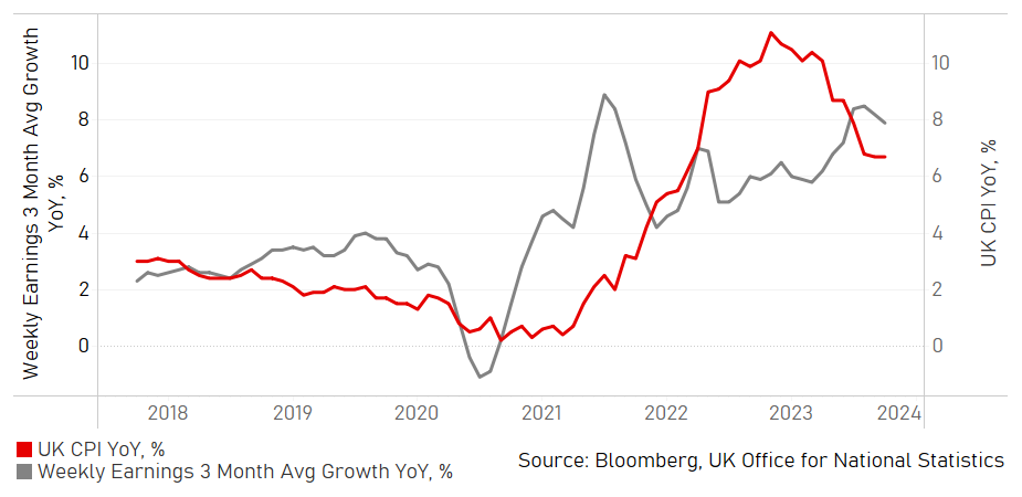
UK-US 10YR YIELD SPREAD
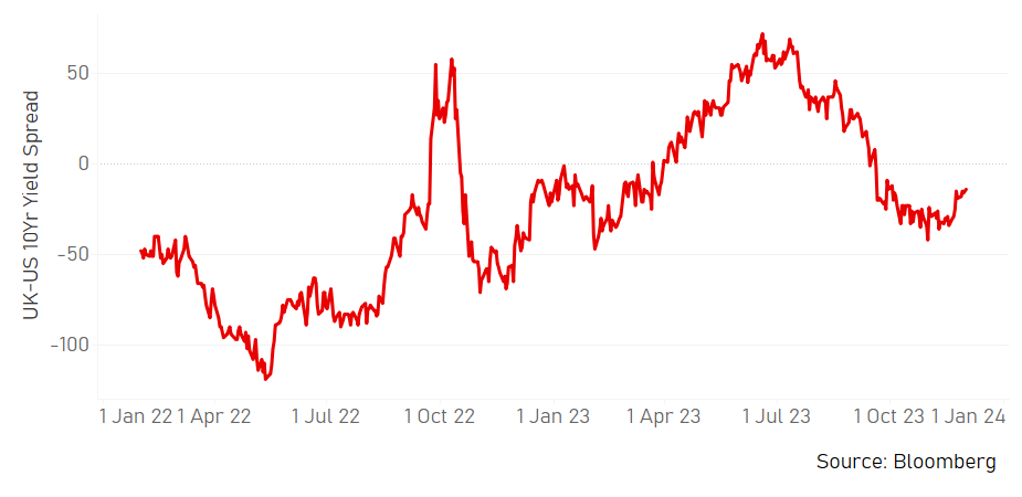
Chinese renminbi
|
Spot close 30.11.23 |
Q1 2024 |
Q2 2024 |
Q3 2024 |
Q4 2024 |
|
|
USD/CNY |
7.1350 |
7.0500 |
6.9500 |
6.8500 |
6.8000 |
|
USD/HKD |
7.8093 |
7.8000 |
7.7900 |
7.7900 |
7.7800 |
|
Range |
Range |
Range |
Range |
||
|
USD/CNY |
6.8500-7.2500 |
6.7500-7.1500 |
6.6500-7.0500 |
6.6000-7.0000 |
|
|
USD/HKD |
7.7700-7.8500 |
7.7600-7.8400 |
7.7600-7.8400 |
7.7500-7.8300 |
MARKET UPDATE
In November, USD/CNY decreased from 7.3158 to 7.1372. The PBOC held the 1-year MLF unchanged at 2.50% on 15th November and kept its 1-year and 5-year LPR rates stable at 3.45% and 4.20% respectively on 20th November.
OUTLOOK
Sentiment on China remained low in November, as indicated by a 2.1% decline in China’s benchmark CSI 300 equity index. China’s equity market also experienced a mild net capital outflow of USD0.2bn by foreign institutional (FI) investors, after prior three months’ heavy selling by FI investors. Market sentiment is weighted by the 9.4%yoy contraction of year-to-date utilized FDI, the contraction in year-to-date property sales and major activity indicators of the sector including new floor space started in October. Moreover, the latest November China PMIs caused increased concerns over the sustainability of China’s growth. The manufacturing PMI worsened marginally to 49.4 (down from October’s 49.5), the non-manufacturing PMI dropped to 50.2 (down from October’s 50.6) and the composite PMI slid to 50.4 (down from 50.7 in prior month).
Despite the deterioration in business sentiment, there were further positive policy initiatives by government in November. Chinese governments have been increasingly working on various policy stimulus and still planning to roll out more support for property sector and overall economy, including encouraging financial sectors to step up credit support for developers and mortgage demand, shifting towards a two-market housing model to allow market to play more role (developing more affordable housing while retaining a separate commercial housing market), as well as policy support to lift demand and restore sentiment in property sector and etc. These would help commercial housing to be determined more by market forces. It is an important policy change, from emphasizing the “three red line policy to current promoting credit lending to real estate sector”. This change and new policy can truly help alleviate the risk of the liquidity crunch faced by developers and help satisfy the funding needs of the developers. We expect these policies to eventually help stabilize the sector’s activity in 2024.
The government’s recent action in increasing its budgeted fiscal deficit for 2023 and strengthens our expectation for a gradual pick up in consumption and investment ahead and in 2024. We think that it is possible for China to realize the “around 5%” growth target for this year set in this March’s NPC meeting, and to achieve 4.8~5% growth in 2024. As a result we expect the GDP growth target for 2024 to set at “around 5%” too. China’s domestic demand recovery will be helped by a favourable restocking process of industrial production in 2024 after a lengthy period of destocking. Chinese assets and the CNY are still weighted down by pessimism, the repairment of sentiment as economic activity stabilizes and improves will help strengthen the currency in the year ahead. We expect USD/CNY to decline to 7.0500 by Q1 2024 and 6.8000 by Q4 2024.
INTEREST RATE OUTLOOK
|
Interest Rate Close |
Q1 2024 |
Q2 2024 |
Q3 2024 |
Q4 2024 |
|
|
Loan Prime Rate 1Y |
3.45% |
3.45% |
3.35% |
3.25% |
3.25% |
|
MLF 1Y |
2.50% |
2.50% |
2.40% |
2.30% |
2.30% |
|
7-Day Repo Rate |
1.80% |
1.80% |
1.70% |
1.60% |
1.60% |
|
10-Year Yield |
2.68% |
2.70% |
2.68% |
2.65% |
2.65% |
* Interest rate assumptions incorporated into MUFG foreign exchange forecasts.
We saw an important development on the fiscal policy front. The government increased the budgeted fiscal deficit for this year by allowing the issuance of additional RMB1 trillion government bonds for infrastructure spending. This implies a change in fiscal policy stance and a more pro-active fiscal policy in 2024, but the high level of government debt implies that fiscal stimulus has its restrictions. China still needs a collaborate monetary policy to help stimulate domestic demand. In recent months, the sharp decline of CPI headline inflation to near 0%yoy, has been pushing up real interest rates in China, while nominal rates remained largely stable. Rising funding costs amid weak domestic demand necessitate further policy rate cuts in China. We expect 30-50bps of RRR cuts, and 20~30bps of policy rate cuts in Q2 and Q3 of next year. As we think that a recovery in financing demand in the real economy is the main reason for interest rates to climb and the situation of arising government bond yields often is accompanied by an increase in available high yielding assets, China’s 10-year government yield will remain low in 2024.
ON A SEQUENTIAL BASIS, PROPERTY INVESTMENT GROWTH FELL IN OCT
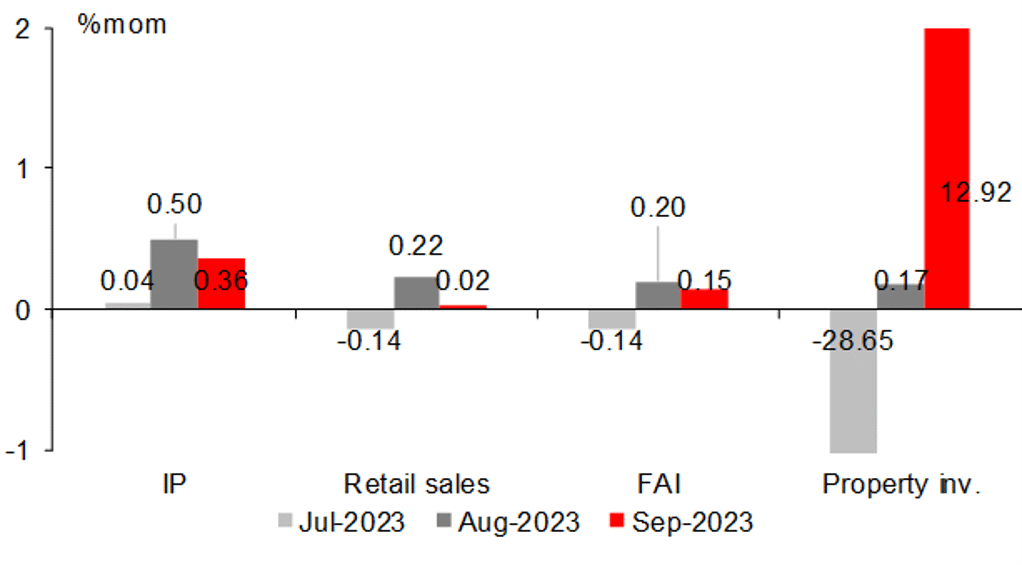
Source: CEIC, MUFG GMR
CHINA FACTORY ACTIVITY CONTRACTED FOR SECOND MONTH IN NOV
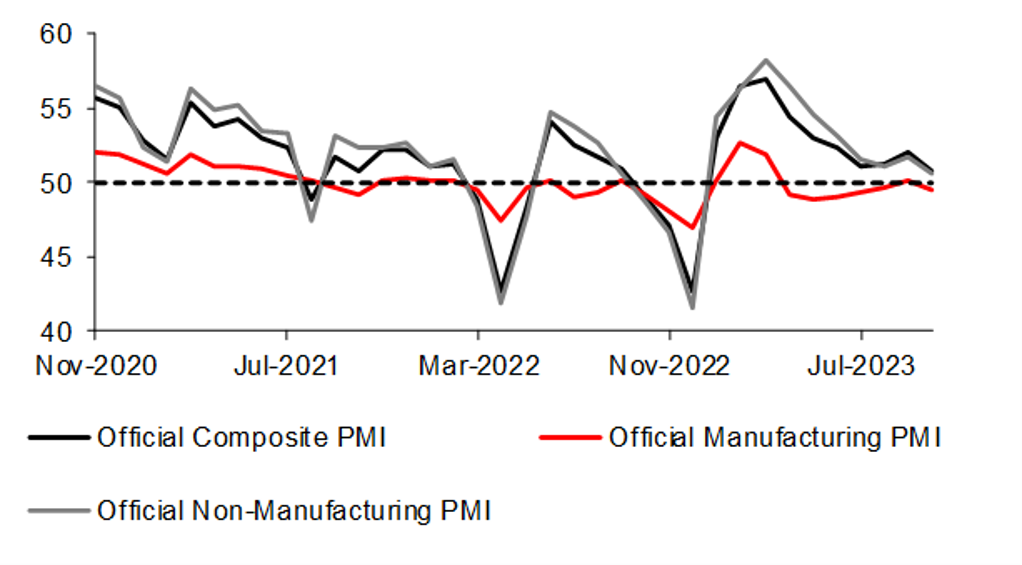
Source: CEIC, MUFG GMR



